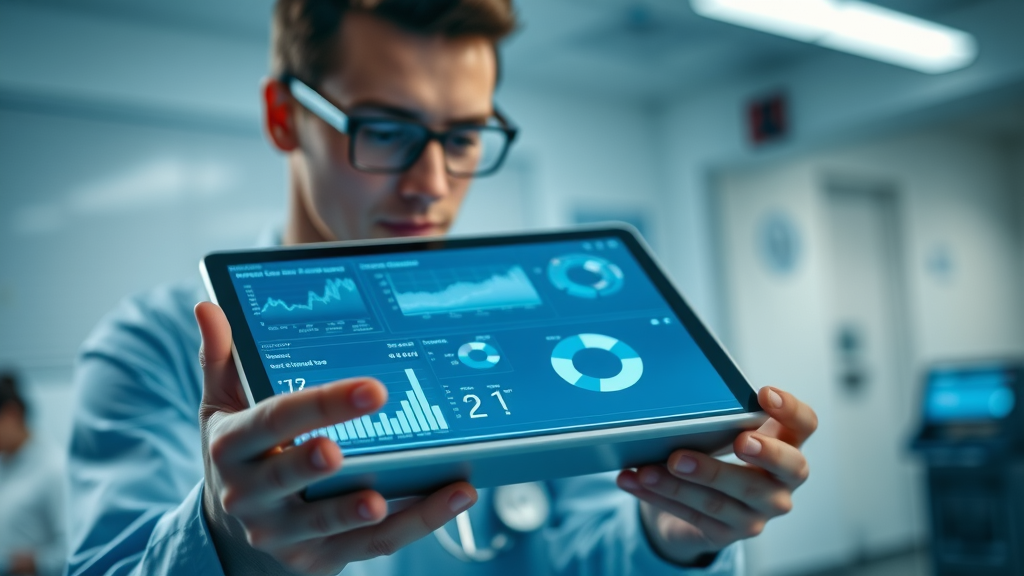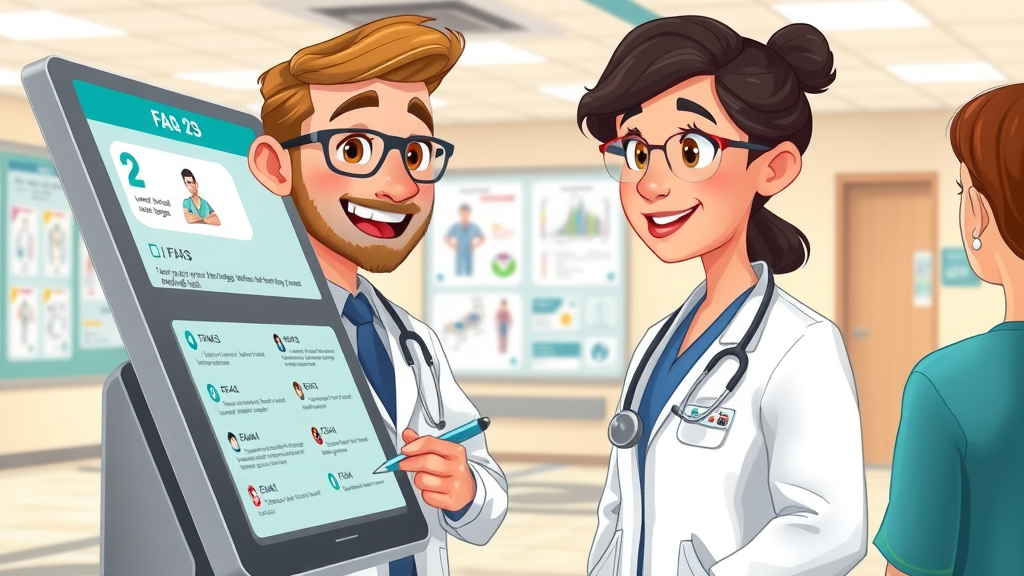"Healthcare data analysis can reduce adverse patient outcomes by up to 40%, according to leading industry research. Every missed insight could mean a preventable risk."
Imagine preventing almost half of hospital complications and saving countless lives—just by seeing what’s hidden in digital health records. Healthcare data analysis is rapidly transforming how health care organizations identify patient risks, tailor treatment, and deliver safer care. In today’s data-driven world, tapping into the power of care data isn’t just a competitive advantage—it’s a necessity. This comprehensive guide will show you how healthcare data analysts and advanced data analytic strategies are rewriting the rules for modern patient care.
The Critical Role of Healthcare Data Analysis in Modern Health Care
As the backbone of the modern health care system , healthcare data analysis serves as the bridge between big data and tangible improvements in patient outcomes . By synthesizing unstructured health data from myriad sources—like electronic health records, wearables, and even social determinants—care data analysts reveal hidden threats and early warning signs. This proactive approach enables care professionals to intervene early, reducing readmissions and adverse events, while optimizing resources for the best possible patient care.
Every day, hospitals and care organizations employ care data analytics to streamline workflows and ensure compliance with privacy laws, such as HIPAA in the United States. By deploying advanced analytics tools, healthcare data analysts collaborate with clinical teams to make informed decisions about treatments and discharge planning. Real-time access to actionable insights empowers doctors, nurses, and administrators to enhance patient outcomes and streamline the care delivery process.
The critical applications of healthcare data analysis also extend beyond patient safety. It fosters a culture where public health , medical research, and hospital operations unite to prevent complications and reduce resource waste. In essence, health care organizations leveraging sophisticated data analytics not only uncover patient risks but also set new standards for care excellence.

- Rapidly detect patient risks and intervene before complications arise
- Optimize patient care for better health outcomes and fewer adverse events
- Streamline resource allocation and reduce unnecessary costs in care settings
- Enable health care professionals to make faster, data-driven decisions
What You'll Gain from Mastering Healthcare Data Analysis
- Understand the foundational concepts of healthcare data analysis
- Identify how health care organizations leverage data analyst teams
- Recognize patient risk factors and improve care data report accuracy
- Learn how healthcare data analysts interpret valuable data
- Apply data analytic strategies to drive better health data outcomes
Healthcare Data Analysis Fundamentals: Terminology, Types, and Tools
Before you can fully appreciate the value of healthcare data analysis , it's crucial to get familiar with the core concepts, types, and technology tools that power this transformative field. Let’s demystify the jargon and discover what makes healthcare data unique within the care industry.
The process begins with collecting vast volumes of care data —from clinical information and insurance claims to wearable device stats. This data must then be standardized and assessed by a skilled data analyst dedicated specifically to the complexities of health care. The role of a healthcare data analyst goes beyond spreadsheets; it requires an in-depth understanding of medical terminology, ethics, and care systems.
Whether working with big data from thousands of patients or highly specialized datasets for clinical trials, the right use of data analytics tools can illuminate patient risks that traditional reporting might miss. From trend analysis to risk prediction, healthcare data analysts are transforming the landscape of care one insight at a time.

Defining Healthcare Data and Care Data Analytics in the Care Industry
- Healthcare data : Information generated from any health care process, including lab tests, imaging, clinical notes, and claims.
- Data analytics : The use of statistical and computational methods to derive patterns and actionable insights from health data.
- Care data analyst : A specialist who interprets complex health data, translating it into strategies that improve patient care and streamline operations in the care industry.
Types of Data Used in Health Care Data Analysis
- Electronic health records (EHR)
- Claims data from insurance and billing systems
- Wearable device and remote monitoring information
- Clinical trial data
- Social determinants of health (e.g., socioeconomic factors)
| Data Source | Example Use Case | Strengths | Limitations |
|---|---|---|---|
| Electronic Health Records (EHR) | Tracking patient history and outcomes | Highly detailed; longitudinal view | Data entry inconsistency; privacy concerns |
| Claims Data | Billing trends; population health analysis | Large datasets; identifies spending patterns | Lacks clinical detail |
| Wearable & Remote Monitoring | Long-term monitoring of chronic conditions | Continuous, patient-generated data | Device variability; patient compliance |
| Clinical Trial Data | New treatment evaluation | Controlled, high-quality data | Small populations; limited scope |
| Social Determinants of Health | Predicting risk based on environment | Holistic care planning; preventive focus | Data is often qualitative or incomplete |
Unveiling the Four Types of Data Analytics in Healthcare
The heart of effective healthcare data analysis lies in leveraging four core analytic methods to support better decision-making. Understanding descriptive, diagnostic, predictive, and prescriptive analytics gives organizations the framework to not just explain or react, but also anticipate and improve patient outcomes steadily.
Integrating these analytic approaches allows health care organizations and care professionals to see patterns, identify root causes, forecast future risks, and take preemptive action in real time. Such analytics also boost value-based care by demonstrating concrete results to payers and patients alike.
By applying these analytics within care data analytics teams, every stage of the patient journey— from admission to recovery—can be optimized, providing better safety, cost efficiency, and overall satisfaction in the care industry.
Descriptive Analytics in Healthcare Data Analysis

- Monitor historical health data and patient outcomes for trends
Descriptive analytics form the foundation of healthcare data analysis by summarizing historical data and revealing patterns in patient care, outcomes, or population health trends. Hospitals use descriptive analytics to monitor infection rates, readmission statistics, and other historical outcomes, benchmarking their performance against standards or regulatory goals.
This type of analysis relies on dashboards, charts, and reports that consolidate health data from various departments. When presented effectively, these summaries empower care professionals to quickly spot new trends. Actionable insights drawn from descriptive analytics pave the way for performance improvements throughout the care system , ensuring the right questions get asked about patient needs and workflow gaps.
Descriptive analytics are crucial for transparency, compliance, and general patient safety , acting as the starting block for further, more advanced data analytic explorations in any health care environment.
Diagnostic Analytics for Root Cause Health Care Insights
- Analyze patient care data to reveal reasons for adverse events
Building on descriptive data, diagnostic analytics delve into the “why” behind adverse events or unexpected results. When infection spikes or unplanned readmissions are flagged, diagnostic tools empower data analysts to mine health data for contributing factors—such as delays in medication administration or incomplete discharge instructions—that may have led to these issues.
By identifying the root cause, diagnostic analytics help care data analysts recommend evidence-based changes, driving targeted quality improvements. This approach not only addresses clinical challenges as they arise, but also assists in developing protocols, training initiatives, and performance measures that sustain high levels of patient care in the long term.
Such diagnostic work is often instrumental in responding to external audits or regulatory reviews, offering an unbiased, data-backed view of internal processes within the care industry .
Predictive Analytics: Foreseeing Patient Risks with Data Analytics
- Use health informatics to project future patient outcomes and health events
Predictive analytics harness the full potential of big data in healthcare settings. These models use historical data and machine learning algorithms to anticipate patient risks and clinical deterioration—such as predicting which cardiac patients are at highest risk for readmission. The output enables earlier, sometimes lifesaving, interventions.
Hospitals that deploy predictive analytics as part of their care data analytics toolbox can improve care planning and resource management, especially in high-risk populations. These data-driven forecasts not only mitigate adverse patient outcomes, but help reduce unnecessary costs associated with readmissions or avoidable complications for health care organizations.
Predictive analytics arguably represent the cutting edge of care, where health informatics skills and data science tools combine to drive truly proactive patient management across all care settings.
Prescriptive Analytics: Recommending Actionable Solutions in Health Care
- Optimize patient treatment plans and resource allocation using prescriptive insights
Prescriptive analytics go one step further, offering concrete recommendations for action. By weighing multiple variables—clinical evidence, staffing levels, policy guidelines, and more—prescriptive models suggest the best treatments or workflows for specific patients. This toolset enables health care organizations to intelligently allocate limited resources where they are needed most, further improving patient outcomes.
These analytics are especially valuable for emergency departments or intensive care units where decisions are high stakes and time is limited. Healthcare data analysts working with prescriptive analytic systems help translate granular data into real-world improvements, supporting care professionals as they strive to deliver safer and more efficient care.
In an era of value-based reimbursement, prescriptive solutions provide the evidence needed to justify interventions and resource investments, enabling health care organizations to remain at the forefront of industry benchmarks.
The Impact of Healthcare Data Analysts in the Care Industry

Behind every successful care data analytics program stands a team of highly trained healthcare data analysts . Their impact in the care industry stretches far beyond software and algorithms—they are the translators who connect clinical intent with actionable, data-backed strategies. As key partners alongside clinicians and administrators, these data analysts ensure that information flows seamlessly to drive informed decision-making and positive patient outcomes .
The demand for healthcare data analysts in the care sector is only growing. As advanced data strategies become the norm, these professionals are at the epicenter of transformation, enabling care organizations to not just survive, but thrive amidst complexity.
Whether working at hospitals, public health agencies, private practices, or research labs, a qualified care data analyst is vital for harnessing the full power of data analysis in health care.
Day-to-Day Responsibilities of a Healthcare Data Analyst
- Gather, clean, and interpret health care data
- Collaborate with care professionals for actionable insights
- Drive quality improvements in patient care
On any given day, a healthcare data analyst might build dashboards that visualize trends, validate incoming data streams, or support clinicians during case reviews. They bridge the technical and clinical dimensions of the health care landscape—often working as translators who turn complex datasets into clear, actionable recommendations for care professionals.
Core tasks regularly include setting up new analytics projects, sharing results with leadership, and supporting the development of best practices for data-driven decision-making. In high-performing hospitals, these analysts are not only seen as technical experts but as essential contributors to the mission of improve patient care and outcomes .
Collaboration with diverse teams—including IT, nursing, and public health—makes this an ever-evolving analyst job , one that demands versatility, critical thinking, and a passion for continuous improvement.
Skills Every Care Data Analyst Needs in Health Care
- Core competencies: data analysis, statistics, health informatics, communication, and ethics
Success as a care data analyst requires more than just technical skills. The best professionals master data analytics and statistical techniques, but also combine them with solid communication abilities and ethical judgment. Being able to explain complex results to non-experts and advocate for data privacy are equally important.
With new data sources emerging constantly and health informatics systems evolving, ongoing training and professional development are essential. Top care data analysts stay abreast of software updates, compliance regulations in the United States, and the latest trends in AI and machine learning.
Increasingly, skills in project management, teaching, and interdisciplinary teamwork separate truly outstanding healthcare data analysts from the pack. Their ability to lead care data analytics initiatives impacts both patient safety and organizational efficiency.
| Qualification | Healthcare Data Analyst | General Data Analyst |
|---|---|---|
| Required Education | Bachelor's or Master's in Health Informatics, Biostatistics, or related fields | Bachelor's in Mathematics, Economics, or Computer Science |
| Industry Knowledge | Medical terminology, regulatory compliance (e.g., HIPAA) | Business or finance, general data management |
| Analytical Tools | EHRs, health care specific software (Epic, Cerner); advanced analytics platforms | General BI tools (Excel, Tableau, Python, SQL) |
| Typical Roles | Health care provider, hospital, insurance, public health agency | Finance, marketing, supply chain, e-commerce |
"A skilled healthcare data analyst bridges the gap between raw data and improved patient outcomes."
Healthcare Data Analysis Process: From Collection to Action
Effective healthcare data analysis is not just about collecting information—it’s about systematically transforming raw health data into practical, life-saving solutions. The process itself is a delicate blend of technology, teamwork, and stakeholder engagement.
From data collection and validation to analysis and communication, each step demands precision, transparency, and a strict adherence to privacy standards. At every phase, the active collaboration of care professionals ensures that analytics stay patient-centered and ethically sound.
Where advanced data and industry regulations intersect, an efficient data analysis process guarantees greater trust and actionable results for health care organizations and their patients.
Step-by-Step Guide: Conducting Effective Healthcare Data Analysis
- Collect and validate health data sources
- Apply analytic techniques and validate findings
- Communicate actionable results to care professionals

Step 1: Data Collection & Validation. Quality analysis begins with robust data—sourced securely from EHR systems, remote devices, and claims databases. Strict validation ensures the data’s integrity and usability, minimizing the risk of privacy breaches or incorrect conclusions.
Step 2: Data Analytics & Interpretation. Next, analytical techniques—from basic statistics to machine learning—are applied, tailored to the project’s aim (e.g., identifying readmission risks, improving discharge workflows). Every result is double-checked for accuracy by a trained data analyst .
Step 3: Insight Communication & Action. The final step involves sharing insights with clinical teams in an accessible way. Recommendations are integrated into hospital protocols or patient care plans, so improvements are directly linked to data-driven evidence.
Best Practices: Health Informatics and Secure Data Management
- Emphasize data privacy, compliance, and ethical standards in health care
Healthcare data analysis success hinges on strict adherence to health informatics best practices. That means securing all health data streams, regularly updating access controls, and maintaining clear audit trails within health care systems. Privacy standards like HIPAA protect patient data, while regular training sessions ensure that all staff—technical and clinical alike—understand and comply with ethical obligations.
Robust data governance ensures that sensitive patient information is safeguarded at rest and in transit. Leading organizations also invest in regular audits, penetration testing, and policy reviews to continuously strengthen their care data analytics infrastructure.
Ethical considerations span everything from data anonymization to bias prevention in algorithms. By putting patient privacy and safety above all else, health care organizations can foster trust and drive lasting improvements in care outcomes.
Case Studies: Real-Life Examples of Data Analytics Success in Health Care
Evidence-based case studies highlight how care data analytics are making an impact from city hospitals to rural clinics in the United States. These real-world successes underscore both the possibilities and best practices when implementing advanced data analysis in health care.
From reducing hospital readmissions to flagging overlooked chronic conditions, proactive analytics set the stage for what’s possible when data, technology, and clinical expertise align.
Learn from these highlights to see how your own care organization can transform outcomes and reduce costs by harnessing the power of healthcare data analysis .
Reducing Hospital Readmissions with Predictive Analytics
- Case: A major hospital’s use of predictive models to identify at-risk patients and tailor interventions

In one notable example, a leading urban hospital implemented predictive analytics to reduce costly and dangerous hospital readmissions. By analyzing electronic health records and claims data, the hospital’s care data analysts identified patients at greatest risk of returning within 30 days of discharge—often due to complex conditions or social vulnerabilities.
Care professionals used these insights to design patient-specific intervention plans, which included closer post-discharge follow-ups, medication reminders, and social support referrals. As a result of these targeted analytics, the hospital saw a dramatic drop in readmission rates and improved both patient outcomes and overall cost efficiency.
This real-world win highlights the essential role data analytics play in predictive strategy, allowing hospitals to move from reactive fixes to proactive success in patient care.
Early Detection of Chronic Conditions with Care Data Analysis
- Example: Using health data analytics to flag undiagnosed diabetes from EHRs
Another case involved a community clinic that leveraged health data analytics to identify undiagnosed chronic diseases—specifically diabetes—hidden in EHRs. By applying advanced data analytic algorithms to clinical records, care professionals flagged patterns of abnormal blood glucose, frequent infections, and unexplained weight changes, even when the diagnosis hadn’t yet been entered.
The care data analyst team then alerted primary care physicians to investigate these patients further, leading to dozens of early diagnoses and timely treatment interventions. This proactive use of care data analytics not only improved patient health but also reduced downstream costs related to untreated chronic illness.
Such examples prove the life-saving power of data analytics in shifting the paradigm from sick care to truly preventive care in the modern care industry .
Challenges and Solutions in Healthcare Data Analysis

For all the promise of healthcare data analysis , real-world implementation faces obstacles: fragmented data, competing priorities, talent shortages, and strict regulatory compliance. Overcoming these barriers is essential for organizations who want to realize the full potential of their care data analytics investments.
The complexity of managing different health care data sources—from siloed EHRs to third-party apps—requires flexible systems and ongoing training for all data analysts . Forward-thinking leaders allocate resources to modernize infrastructure and nurture cross-disciplinary alignment.
With smart strategies and a culture of proactive collaboration, health care organizations can turn today’s data challenges into tomorrow’s opportunities for improved patient care .
Common Barriers to Effective Health Data Analytics
- Data silos, incomplete records, privacy hurdles, and lack of analytic talent
Many health care organizations struggle with data silos —systems that don’t easily share information—leading to piecemeal views of patient history and limiting the success of care data analytics . Data quality issues and incomplete records further complicate the analysis, skewing findings or leading to missed risks.
Privacy regulations in the United States, while crucial, can make accessing data more complex for care professionals. At the same time, the demand for trained data analysts and data scientists continues to outpace supply, making it difficult to fill every open analyst job posting within the care sector.
Overcoming these common barriers is fundamental for any organization hoping to harness the full capabilities and return on investment of healthcare data analysis.
Strategies to Overcome Obstacles in Healthcare Data Analytics
- Interoperability standards, ongoing data analyst training, robust governance
Organizations turning these barriers into growth opportunities typically invest in interoperability standards, enabling different systems to efficiently share health data . Ongoing training ensures that care data analysts remain adept at the latest analytics tools and compliance standards, while robust data governance policies protect privacy and promote data integrity.
Innovative care systems are adopting artificial intelligence, machine learning, and advanced data management practices to bridge siloes, standardize record formats, and safeguard sensitive information. By nurturing cross-disciplinary teams—including IT, clinical leaders, and data scientists—organizations can sustain continuous improvement cycles that support healthy patient outcomes .
In healthcare data analytics, overcoming obstacles is as much about culture and leadership as it is about technology. Organizations that prioritize transparency, collaboration, and lifelong learning lead the way in the care industry.
"Overcoming healthcare data analysis challenges improves patient care and operational efficiency."
Emerging Trends in Healthcare Data Analysis and Data Science
Rapid advances in artificial intelligence, machine learning, and automation are reshaping the landscape of care data analytics . The future belongs to those who not only keep pace with technology, but also reimagine the roles of health care professionals within this evolving context.
Today’s healthcare data analysts are learning new skills in cloud computing, natural language processing, and real-time analytics platforms. These emerging trends promise earlier interventions, greater personalization in care, and more cohesive connections across the care system .
As the data science revolution continues, expect hybrid roles and cross-disciplinary teams to become the norm in the care industry , driving even stronger results for patients and providers alike.
AI, Machine Learning, and Health Informatics in Predicting Patient Outcomes
- Cutting-edge use cases: advanced analytics for early intervention and precision care

Emerging innovation in health informatics brings together artificial intelligence, deep learning, and big data analytics to support highly accurate predictions about patient outcomes . Systems can now analyze vast health data streams in real time, alerting care teams when a patient’s condition changes or identifying the earliest signals of disease.
Hospitals are piloting smart algorithms to triage patients, optimize resource allocation, and personalize care plans. These capabilities not only minimize adverse events but also lay the groundwork for precision medicine—tailoring interventions to individual genomes, lifestyles, and environmental factors.
As these advanced systems evolve, data science skills will become a foundational element for every aspiring care data analyst, strengthening both the art and science of medicine for the next generation.
The Future Role of Healthcare Data Analysts in Health Care
- Hybrid roles, continuous professional development, and cross-disciplinary collaboration in the evolving care industry
The future of care data analysts will extend well beyond technical analytics. As the care industry becomes more integrated, tomorrow’s data analysts will find themselves collaborating with clinicians, IT, researchers, and even policymakers to ensure healthcare data analytics align with every facet of patient well-being.
Roles will become increasingly hybrid: blending data interpretation, ethical leadership, project management, and a strong commitment to lifelong learning. Meanwhile, continuous professional development will be essential to keep pace with new tools, regulations, and care delivery models.
Ultimately, healthcare data analysts of the future will help create a safer, coordinated, and more patient-centered care landscape through sophisticated, collaborative, and transparent data practices.
People Also Ask About Healthcare Data Analysis
What is data analysis in health care?
- Healthcare data analysis is the systematic evaluation of health data to derive insights that improve patient outcomes, enhance clinical decision-making, and optimize health care service delivery.
What are the four types of data analytics in healthcare?
- Descriptive, diagnostic, predictive, and prescriptive analytics are the four main types, each serving a unique role in health care data analytics.
What do healthcare data analysts do?
- Healthcare data analysts gather, clean, and interpret health data, generate actionable insights, and collaborate with clinicians to improve patient care and operational efficiency.
What is an example of data analytics in healthcare?
- A notable example: Using predictive analytics to identify high-risk patients for congestive heart failure and implementing targeted interventions to reduce hospital readmissions.
Frequently Asked Questions About Healthcare Data Analysis

-
How does healthcare data analysis differ from general data analytics?
While general data analytics focuses on insights from any industry, healthcare data analysis requires specialized knowledge of medical terminology, regulatory frameworks (like HIPAA), and patient privacy. It involves unique datasets, tools, and ethical standards tailored to the care industry. -
What credentials are needed to become a healthcare data analyst?
Most healthcare data analyst jobs require a bachelor’s or master’s in fields such as health informatics, biostatistics, data science, or public health. Industry-specific certifications, experience with EHR systems, and skills in statistical software are also highly valued in job postings. -
What are the biggest ethical challenges in health care data analytics?
Protecting patient privacy, obtaining informed consent, ensuring data accuracy, and preventing algorithmic bias are key ethical challenges. Adhering to GDPR, HIPAA, and industry best practices is essential for ethical care data analytics. -
How do healthcare organizations use data analysis to optimize costs?
By uncovering inefficiencies, predicting expensive health events, and personalizing interventions, care organizations reduce unnecessary procedures, minimize readmissions, and allocate resources more efficiently—all leading to significant cost savings while improving patient outcomes.
Summary: Leveraging Healthcare Data Analysis for Hidden Patient Risk Identification
- Healthcare data analysis empowers health care professionals to detect hidden risks, enhance patient outcomes, and enable informed decision-making. Organizations investing in comprehensive health data analytics will lead the charge in quality patient care.
Take Action: Unlock the Full Potential of Healthcare Data Analysis in Your Organization
- Empower your team with the right healthcare data analysis tools and expertise to reduce patient risk and drive meaningful improvements in care delivery today!
 Add Row
Add Row  Add
Add 




Write A Comment